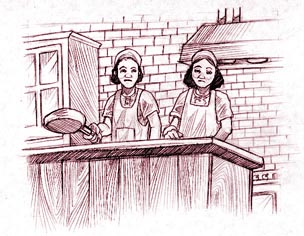The Anglicans for a long time followed a policy of prohibiting miscegenation of the staff. Although the Anglicans' desperate staff shortages after 1945 made the rigid enforcement of such a policy impossible, old attitudes lingered for a long time.
The reaction of communities to the racist assumptions and programs of the residential schools in general are clear. Many demonstrated their revulsion at the attempts at coercive assimilation during and after their school days. At Spanish, reported a Jesuit, the boys 'hate the chapel.' On the prairies, 'a recent graduate of the Birtle School who had professed faith in Christ returned to heathenism' during summer observation of the Thirst Dance on his home reserve. As William Wuttunee of Saskatchewan noted, 'Indians [were] warned by Christians not to attend sun dance but always went anyway.' Indeed, residential school graduates were active in prairie dances and Northwest Coast potlatches, both of which were technically illegal between 1894 and 1951. As adults, others complained that the schools had been 'the means of segregation and the destruction of family unity,' and a technique for destroying Indian identity.
GENDER ISSUES



